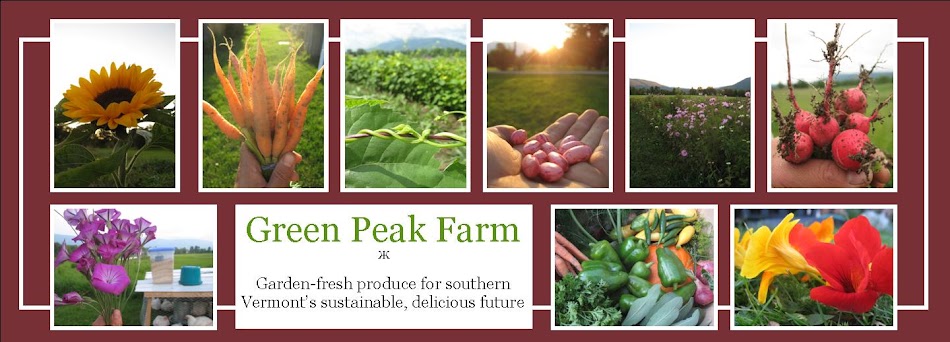The past two weeks have started to really feel like summer, and three cheers for that! The last of the spring chickens were harvested today (THANK YOU Ellen, Bill, Anna, Jamie, Renee, Alex, and Sophia!), the first new potatoes were dug for Sunday's market, the pickle-putting up has begun, peppers are sizing up nicely, green and purple beans are harvestable, and the cukes and zukes are out to get me with a (growing) vengeance. Hooray!
Tomorrow will find you with two more fresh chickens ready for the oven or freezer, and I truly hope that you're enjoying the birds. It is a great joy to me to have had such great helpers in keeping the processing times quick and lively, and I am very pleased with how the entire process turned out. Both chicken harvest days have been exhausting, gratifying, and thoroughly educational-- there has been a lot of knowledge sharing that to me, is the heart of the matter-- everyone helping out and pooling our collective resources for what I think, and I hope you agree, is a stellar product. There are many, many ways to turn a chicken into Chicken, and I think our way is in tune with respecting the life of the animals and the bounty they can provide. Putting the birds into a natural, trance-like state relaxes the birds' muscles, lowers the heart and breathing rates, and prevents the panic-release of stress hormones into the meat. Hand plucking feathers is sometimes tedious and slow, but on this scale, "slow" is an opportunity to notice the different sections of skin, the different directions to pick feathers from, the development of more down and hair (as this week's set proved) and a handful of other nuances and small notable moments to think on. Yes, it's slow and takes a significant amount of time per bird, and yes, I've been incredibly lucky to have let this become a part of my daily life-- but to me it is that significance, those opportunities to recognize the chaos and beauty, and then the inherent appreciation that are critical, missing links in our current mainstream food system. I believe that these things matter. So, with all that Ado, it's my honor to provide your weekly shares, and these chickens, with the help of several fearless, kind souls with trusty hands. I'm raising my glass to you, Cheers!
Here's one of my all-time favorite poems, in honor of the furious outpouring of growth, beauty, and production we call summer. Go ahead and read it aloud for its phenomenal rhythms!
From Blossoms - By Li-Young LeeFrom blossoms comes
this brown paper bag of peaches
we bought from the boy
at the bend in the road where we turned toward
signs painted
Peaches.From laden boughs, from hands,
from sweet fellowship in the bins,
comes nectar at the roadside, succulent
peaches we devour, dusty skin and all,
comes the familiar dust of summer, dust we eat.
O, to take what we love inside,
to carry within us an orchard, to eat
not only the skin, but the shade,
not only the sugar, but the days, to hold
the fruit in our hands, adore it, then bite into
the round jubilance of peach.
There are days we live
as if death were nowhere
in the background; from joy
to joy to joy, from wing to wing,
from blossom to blossom to
impossible blossom, to sweet impossible blossom.

 Also available are scanned images for data on food storage relative humidity, temp range, and conditions.
Also available are scanned images for data on food storage relative humidity, temp range, and conditions.  Also available are scanned images for data on food storage relative humidity, temp range, and conditions.
Also available are scanned images for data on food storage relative humidity, temp range, and conditions. 








 I will harvest more on Monday so that everyone can pick up two of their birds this Tuesday. If you’re not heading straight home, bring a cooler. These chickens are exceptionally flavorful and juicy—and thanks to being finished out with corn and soy scratch mix, have a pretty thick, fatty skin. This makes for a great, juicy coating for roasting or deep frying, but if you’d prefer a leaner option, I’d be happy to skin your birds for you. Also, for anyone who is interested in making stock, stuffing, or dog treats, I’ll keep giblets, necks and feet. Birds are whole, and I’ll provide a photocopy of instructions on how to procure cuts like you’d see wrapped in Saran wrap in the grocery store on Tuesday. If anyone is interested in learning to harvest chickens, and wants to help, please let me know.
I will harvest more on Monday so that everyone can pick up two of their birds this Tuesday. If you’re not heading straight home, bring a cooler. These chickens are exceptionally flavorful and juicy—and thanks to being finished out with corn and soy scratch mix, have a pretty thick, fatty skin. This makes for a great, juicy coating for roasting or deep frying, but if you’d prefer a leaner option, I’d be happy to skin your birds for you. Also, for anyone who is interested in making stock, stuffing, or dog treats, I’ll keep giblets, necks and feet. Birds are whole, and I’ll provide a photocopy of instructions on how to procure cuts like you’d see wrapped in Saran wrap in the grocery store on Tuesday. If anyone is interested in learning to harvest chickens, and wants to help, please let me know.


